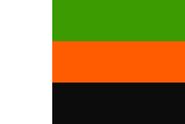Hanebrugish
| Hanebrugish | |
|---|---|
| Hanebrugish | |
 Flag of Hanebrug | |
| Pronunciation | [ˈhäːnəˌbɾʲʉ̞ɣɪʃ] |
| Created by | Charles, xadrezo |
| Date | September 2023 |
| Native to | Hanebrug |
Indo-European
| |
Standard form | West Hanebrugish (Westhanebrugish)
|
Dialects |
|
Hanebrugish (Hanebrugish: Hanebrugish; /ˈhanəbryɡiʃ/), also spelled Hanebruggish, is a Germanic conlang originally developed for Hanebrug, a city founded by a small band of friends (who all happened to be linguistics nerds) on a Minecraft Realm in September 2023. Its lack of umlaut and rhotacism and its other similarities to East Germanic make it characteristically simple and conservative compared to other Germanic languages that are spoken today.
Etymology
Hanebrug is ultimately named after one of Charles' cats, Hannah, who had already been enjoying a sort of celebrity status within the friend group; "Hane" is Charles' favorite nickname for her. The original proposal for the city's name was actually Haneburg, but a typo rendered it Hanebrug; the mistake stuck and the city was thus officially named Hanebrug. In Hanebrugish, Hanebrug can be analyzed as a compound of Hane ("Hannah, Hane") + brug ("bridge"), making the city's name literally translate to "Hanebridge." The term brug comes from Proto-Germanic *brugjǭ, with irregular schwa-deletion (the expected form would be *bruge).
History
Early September 2023 and Vanilla Hanebrug
Hanebrugish was first developed in September 2023 by co-founders Charles (then known by Charlotte) and xadrezo, with the intent of giving Hanebrug a deeper, more defined culture with its own language. Because they wanted it to be both easily made and taught to the rest of Hanebrug, they did away with some of the most characteristic sound changes found in the Germanic languages, like umlaut. Unfortunately, there was never any formal effort to teach the language to the citizens of Hanebrug. Other members of Hanebrug would go on to contribute to the language's development during its first revival effort. Road signs were written in both English and Hanebrugish, as well as official documentations.
Late September—Early October and Modded Hanebrug
Sometime during the later half of September, the friend group decided that they would restart Hanebrug in a modded server. Using the same seed from before, most of the group returned to Hanebrug's location to rebuild it, now with mods. By October, a space race was brewing between Hanebrug and a member who chose to remain at the world spawn. The space race led to a destructive drama that would end with modded Hanebrug being griefed beyond repair. The situation fractured the friend group, effectively killing Hanebrug and the Hanebrugish language along with it.
Early 2024 and the Revival Efforts
In February 2024, Charles, xadrezo and other former members of Hanebrug wanted to revive the Minecraft Realm, thus revitalizing Hanebrugish. More documentation was made on the language; members started to contribute by forming their own dialects of the language, each with their own distinct identity. This initial revitalization effort quickly died out due to even more drama. This would eventually result in one of the co-founders, Charles, being exiled from the friend group.
Even after splitting from the group, Charles still loved the conlang he co-authored and wanted to continue to work on developing it by himself; he has been actively working on it ever since then.
Phonology
Consonants
Hanebrugish has a minimal yet not relatively unusual 16-consonant phoneme inventory.
| Labial | Coronal | Dorsal | Glottal | |||||
|---|---|---|---|---|---|---|---|---|
| Nasal | m | n | ||||||
| Stop | p | b | t | d | k | ɡ | ||
| Fricative | f | s | ʃ | h | ||||
| Approximant | w | l | j | |||||
| Rhotic | r | |||||||
Allophony
- /VN/ codas are allophonically realized as [Ṽː] (compensatory lengthening only applying toward monophthongs).
- e.g. tanf (n. ms. 'tooth') /tãf/ [t̪ɑ̃ːf]
- Note: While this change is not actually phonemic, it is still typically recognized in broad transcription because /n m/ become noncontrastive in the coda.
- /r/ has three standard realizations determined by placement:
- Word-initially, it is trilled [r].
- e.g. road (adj. 'red') /ˈruə̯d/ [ˈruːə̯t̪]
- Word-initially, it is trilled [r].
Vowels
Hanebrugish possesses an extraordinarily minimal, near-vertical 8-vowel inventory, unlike most Germanic languages that tend to have lots of vowel sounds (I mean, just look at Danish).
| Non-back | Back | |||
|---|---|---|---|---|
| short | long | |||
| High | unround. | i | iə̯ | |
| rounded | y | yə̯ | uə̯ | |
| High-mid | e | |||
| Mid | ə | |||
| Low | a | |||